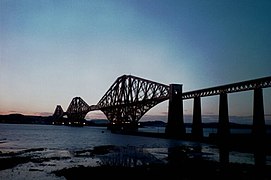Cantilever bridge
This article possibly contains original research. (August 2022) |
heavy rail | |
| Span range | Medium |
|---|---|
| Material | Iron, structural steel, prestressed concrete |
| Movable | No |
| Design effort | Medium |
| Falsework required | Very little to none |
A cantilever bridge is a
The steel truss cantilever bridge was a major engineering breakthrough when first put into practice, as it can span distances of over 1,500 feet (460 m), and can be more easily constructed at difficult crossings by virtue of using little or no falsework.
Origins

Heinrich Gerber was one of the engineers to obtain a patent for a hinged girder (1866) and is recognized as the first to build one. [2]: 79 The Hassfurt Bridge over the Main river in Germany with a central span of 124 feet (38 metres) was completed in 1867 and is recognized as the first modern cantilever bridge.[3]: par. 2

The
The
Function
Cantilever Bridge.—A structure at least one portion of which acts as an anchorage for sustaining another portion which extends beyond the supporting pier.
— John Alexander Low Waddell, Bridge Engineering[4]
A simple cantilever span is formed by two cantilever arms extending from opposite sides of an obstacle to be crossed, meeting at the center. In a common variant, the suspended span, the cantilever arms do not meet in the center; instead, they support a central truss bridge which rests on the ends of the cantilever arms. The suspended span may be built off-site and lifted into place, or constructed in place using special travelling supports.
A common way to construct steel truss and prestressed concrete cantilever spans is to counterbalance each cantilever arm with another cantilever arm projecting the opposite direction, forming a balanced cantilever; when they attach to a solid foundation, the counterbalancing arms are called anchor arms. Thus, in a bridge built on two foundation piers, there are four cantilever arms: two which span the obstacle, and two anchor arms that extend away from the obstacle. Because of the need for more strength at the balanced cantilever's supports, the bridge superstructure often[citation needed] takes the form of towers above the foundation piers. The Commodore Barry Bridge is an example of this type of cantilever bridge.
Steel truss cantilevers support loads by
Prestressed concrete balanced cantilever bridges are often built using segmental construction.
Construction methods
Some steel arch bridges (such as the Navajo Bridge) are built using pure cantilever spans from each side, with neither falsework below nor temporary supporting towers and cables above. These are then joined with a pin, usually after forcing the union point apart, and when jacks are removed and the bridge decking is added the bridge becomes a truss arch bridge. Such unsupported construction is only possible where appropriate rock is available to support the tension in the upper chord of the span during construction, usually limiting this method to the spanning of narrow canyons.

List by length
World's longest cantilever bridges (by longest span):[5]
- Quebec Bridge (Quebec, Canada, 1919) 1,800 feet (549 m)
- Forth Bridge (Firth of Forth, Scotland, 1890) 2 x 1,710 feet (521 m)
- Osaka, Japan, 1973) 1,673 feet (510 m)
- Commodore Barry Bridge (Chester, Pennsylvania, US, 1974) 1,644 feet (501 m)
- New Orleans, Louisiana, US, 1958 and 1988) 1,575 feet (480 m)
- Howrah Bridge (Kolkata, West Bengal, India, 1943) 1,500 feet (457 m)
- Gramercy Bridge (Gramercy, Louisiana, US, 1995) 1,460 feet (445 m)
- Tokyo, Japan, 2012) 1,443 feet (440 m)
- Pointe-à-la-Croix, Quebec, Canada, 1961) 1,247 feet (380 m)
- Horace Wilkinson Bridge (Baton Rouge, Louisiana, US, 1968) 1,235 feet (376 m)
- Tappan Zee Bridge (South Nyack, New York & Tarrytown, New York, US, 1955–2017) 1,212 feet (369 m)
- Lewis and Clark Bridge (Longview, Washington & Rainier, Oregon, US, 1930) 1,200 feet (366 m)
Examples
-
The Quebec Bridge is of the general structure described above.
-
The Vejle Fjord Bridge is a concrete bridge built using the balanced cantilever method.
-
Former eastern span of the San Francisco–Oakland Bay Bridge
-
The Forth Bridge with its three double cantilevers.
-
Original 1938 span of the Blue Water Bridge
-
Vrengen Bridge, a concrete bridge.
References
- ^ a b DuBois, Augustus Jay (1902). The Mechanics of Engineering. New York: John Wiley & Sons. Retrieved 2008-08-10.
- ^ a b Bender, C. (1890). "Discussion on Cantilever Bridges by C.F. Findlay". Transactions of the Canadian Society of Civil Engineers. 3. Canadian Society of Civil Engineers. Retrieved 2008-08-10.
- ^ DeLony, Eric (1996). "Context for World Heritage Bridges". World Heritage Sites. International Council on Monuments and Sites. Archived from the originalon 2005-02-21. Retrieved 2008-08-10.
- ^ Waddell, J. A. L. (1916). Bridge Engineering - Volume 2. New York: John Wiley & Sons, Inc. pp. 1917. Retrieved 2008-08-19.
- ^ Durkee, Jackson (1999-05-24). National Steel Bridge Alliance: World's Longest Bridge Spans (PDF). American Institute of Steel Construction, Inc. Archived from the original (PDF) on 2002-06-01. Retrieved 2007-11-03.
External links
- "Cantilever Bridge" by Sándor Kabai, The Wolfram Demonstrations Project, 2007.
- Biggest of Finished Girders Go Traveling: six giants of 70 tons gave engineers a hard nut to crack, Popular Science monthly, February 1919, page 79, Scanned by Google Books
- . . 1914.









